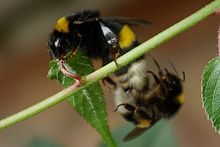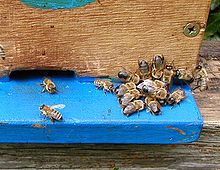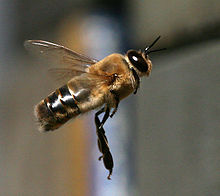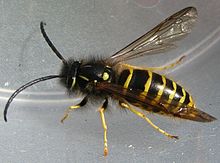Drone (hymenoptera)
The drone , technical terminology also the drone is the male animal in wild bees (esp. Bumble bees ), honey bees and wasps (incl. Hornets ). These state-forming species from the order of the hymenoptera have three different morphs : queen , worker and drone.
The body shape of the drones is usually larger and stockier than that of a worker, they have no sting and the compound eyes are often larger and more efficient. When laying eggs, the queen controls whether an egg is fertilized or not. Drones are created from unfertilized eggs, workers and queens from fertilized ones.
Honeybee drones
In honey bees , which are state-building all year round , the drones only appear in the colony's multiplication phase, the swarming period , from around April to August, but mainly in May and June. The workers create larger honeycomb cells for rearing purposes . By the middle of the year, a strong, healthy bee colony can have a few hundred to a thousand drones. The drones do not take part in any work in the beehive or in collecting pollen and nectar . In contrast to the males of solitary bee species, they are not even able to take in nectar from flowers, but are dependent on the social exchange of food ( trophallaxis ) in the bee colony for their own nutrition . After sexual maturity, they regularly fly out to look for queen bees who can mate, see also drone assembly point .
The copulation with a young queen bee found in a nuptial flight instead. Here the sexual apparatus ( penis ) of the drone is turned out. After copulation, the penis of the drone in the queen bee (left Weisel ), the drone falls by the Queen, and dies. Drones from some wasp species (e.g. hornets ), on the other hand, can mate with queens multiple times. The mating of the bumblebees and all wasp species does not take place in the air, but on the ground.
A short time after the summer solstice , the drone battle takes place. The drones are denied the social exchange of feed and they are already pushed away at the entrance hole, i.e. not allowed into the beehive after their excursions. It also happens that younger drones are dragged out of the beehive by female workers. Due to a lack of food, they are initially unable to fly and eventually starve to death. During this phase, one can often see drones crawling around and dying.
Drone homogenate
A rare apitherapy method, which was only newly developed in 1980, uses a homogenate from drone brood as a possible therapeutically effective substance or as a dietary supplement . The homogenate is called "Apilarnil" after its inventor, the Romanian beekeeper Nicolae Iliesiu. Proponents believe that the high levels of androgens can be useful for hormone replacement therapy . A number of prospective studies are available so far, the results so far are preliminary and do not yet allow a reliable assessment. A survey also showed a rather low level of acceptance among potential users compared to other bee products.
Figuratively speaking, drones
The term “drone” (originally English “drone”) was transferred from male honey bees to unmanned aerial vehicles . This use of language is said to go back to the "Queen Bee" by the British aircraft designer Geoffrey de Havilland . De Havilland was very interested in entomology and named many of his constructions after flying insects, e.g. B. Mosquito , Dragonfly , Tiger Moth . The Queen Bee was the first unmanned tow plane to be produced in large numbers . An American admiral is said to have been so impressed by a demonstration that he commissioned naval officer Delmar S. Fahrney to build similar flying objects, which he named "drone" in 1936, based on De Havilland's name. This name stuck in military parlance and was eventually transferred to civilian flying objects.
Furthermore, in older political polemics, a "drone" referred to the group of property owners, regardless of social age (old nobility, bourgeoisie, nouveau riche).
See also
literature
- Gerhard Liebig : Simply beekeeping. Keep guide to bees . 3rd revised edition, self-published, Bochum 2011, ISBN 3-9803568-6-8
- Heiko Bellmann: Bees, wasps, ants - hymenoptera of Central Europe . 2nd Edition. Franckh-Kosmos Verlag, Stuttgart 2005, ISBN 3-440-09690-4 .
- Paul Westrich: Germany's wild bees. 2nd revised edition, Ulmer, Stuttgart, 2019, ISBN 978-3-8186-0880-4 .
Individual evidence
- ↑ Róża Sawczuk, Joanna Karpinska, Wojciech Miltyk (2019): What do we need to know about drone brood homogenate and what is known. Journal of Ethnopharmacology 245, article 111581. doi: 10.1016 / j.jep.2018.10.042
- ↑ Kemal Çelîk (editor): Apitherapy Handbook. Sonçağ Akademî Yayinlari, Ankara 2019. ISBN 978 605 7851 49 9 .
- ↑ Babür Erdem, Aslı Özkök (2017): Can Food Supplement Produced from Apilarnil be an Alternative to Testosterone Replacement Therapy? Hacettepe Journal of Biology and Chemistry 45 (4): 635-638.
- ↑ Heidrun Männle, Thomas Riepen, Karsten Münstedt (2020): Apitherapeutic means and patients' willingness to accept them. Journal of Apitherapy 7 (1): 15-21 doi: 10.5455 / ja.20191228060053
- ↑ Steve Mills: The Dawn of the Drone: From the Back-Room Boys of World War One. Casemate Publishers, Oxford 2019. ISBN 978-1-61200-789-2 , p. 218.
- ↑ Ben Zimmer: The Flight of 'Drone' From Bees to Planes. Wall Street Journal, July 26, 2013.
- ↑ John F. Keane and Stephen S. Carr (2013): A Brief History of Early Unmanned Aircraft. Johns Hopkins APL Technical Digest 32 (3): 558-571.
- ^ Heinrich Mann: An age is visited, Fischer, Frankfurt am Main, 3rd edition 2001, p. 87.
Web links
- Dieter Kosmeier, Thomas Rickinger, Elmar Billig: Drones - the males of the hornets. In: hornissenschutz.de. October 31, 2016 .
- Joachim Eberhardt: the drone - the male being. In: die-honigmacher.de. April 28, 2010 .




